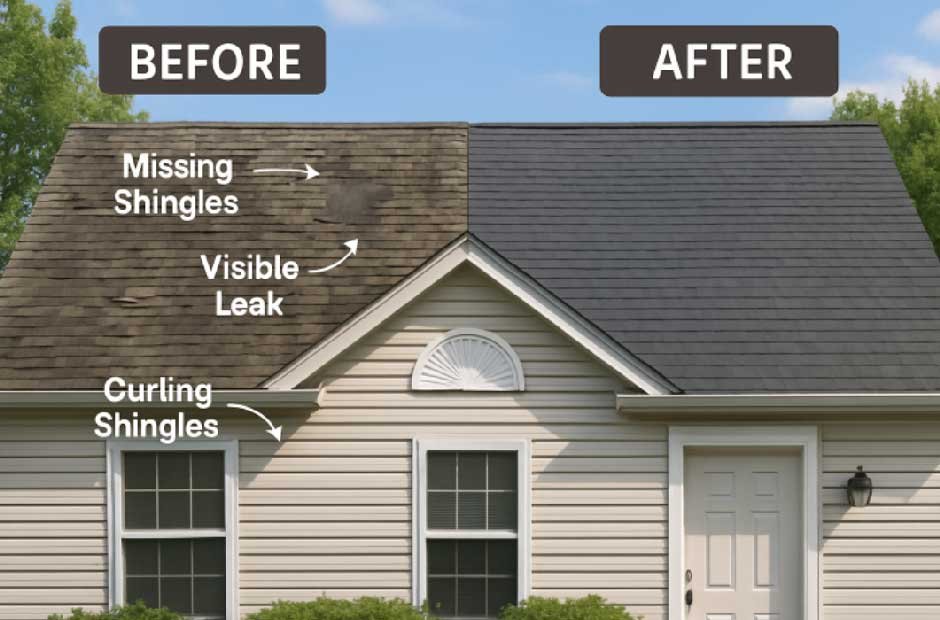Skip to the good bit
ToggleCommon Signs Your Roof Needs to Be Replaced
Recognizing when your roof needs replacement helps prevent costly damage. Look for curling, buckling, missing shingles, water stains, leaks, granule loss, sagging decks, or daylight through attic boards. Ignoring these can lead to mold, rot, and structural issues. For guidance on roof replacement, visit This Old House: Roof Replacement — What to Expect. Acting quickly at the first sign is crucial, as minor issues can escalate. The U.S. Department of Housing and Urban Development emphasizes the importance of regular inspections and prompt repairs to maintain protection and comfort. To learn more about recognizing what your roof needs, click https://www.deltaservices.com/re-roof/.
Factors That Affect the Timing of a Roof Replacement
The optimal time to replace your roof varies based on factors such as material, age, climate, and installation quality. Asphalt shingles typically last 20-25 years, whereas metal or slate options can endure longer. Conditions like severe weather, inadequate ventilation, and storms speed up wear and tear, as mentioned in Forbes: Roof Replacement Guide. Homeowners should evaluate local weather conditions, conduct inspections, and select late spring or early fall for a smoother and more convenient installation process.
Comparing Roofing Materials for Durability and Cost
Choosing the right roofing materials ensures long-term value and protection for your home. Here’s a breakdown of the most popular materials and what sets each apart:
- Asphalt Shingles: The most widely used in the U.S., asphalt shingles are cost-effective and come in various colors and styles. They’re relatively easy to install, but typically offer a shorter lifespan—generally 20 to 25 years.
- Metal Roofing: Prized for its durability, metal resists wind, fire, and rot, and is energy-efficient—often lasting over 50 years. However, its upfront cost is higher, and installation may require specialty contractors.
- Clay or Concrete Tiles: These materials boast superior longevity (up to 100 years) and natural fire resistance. Due to their weight, reinforcing the roof structure is often necessary, and costs can be higher.
- Wood Shingles and Shakes: Offering unique curb appeal, wood is an eco-friendly option but requires more maintenance and is less fire-resistant, which can make it less suitable for certain climate zones.
According to Energy Saver: Roofing Materials, the use of cool roofing materials can further cut energy costs, maximizing efficiency while extending roof longevity.
Step-by-Step Breakdown of the Roof Replacement Process
Understanding the entire replacement process gives homeowners a roadmap for what to expect:
- Inspection and Assessment: A licensed contractor assesses the state of your existing roof, taking measurements, checking for soft spots, and identifying any hidden issues.
- Tear-Off: The old roofing material is carefully removed to expose the roof deck, allowing for thorough inspection of the substrate beneath.
- Deck Repair: Any rotted or damaged decking is replaced to ensure a stable base for new materials.
- Underlayment Installation: A waterproof barrier is laid to shield your home from moisture intrusion further.
- Material Installation: Depending on your chosen material, new shingles, tiles, or panels are installed following industry standards and manufacturer guidelines.
- Cleanup and Final Inspection: The site is cleared of debris, and a thorough final inspection ensures quality and code compliance.
Each of these steps is vital for the safety, longevity, and performance of your new roofing system; therefore, be sure to work with a contractor who follows transparent processes and maintains clear communication.
How to Choose the Right Roofing Contractor
The right contractor is crucial to getting the results you expect. Look for businesses with established reputations in your community, proper licensing and insurance, and positive client testimonials. Ask contractors if they are certified installers for the product you’ve chosen. Request several quotes—not just for price comparisons but also to evaluate professionalism, responsiveness, and warranty offerings. Remember that a well-qualified contractor may not be the cheapest, but they often provide the best long-term value and peace of mind.
Budgeting for a Roof Replacement
Roof replacement is a significant investment. Costs can vary widely depending on the roof size, pitch, materials, labor, and the need for additional repairs, such as decking replacement. Most estimates will break down labor, disposal fees, materials, and any permit costs. Experienced homeowners recommend setting aside 10–15% extra as a contingency for unexpected discoveries that often occur when the old roof is stripped away. For general guidance, consult nationwide averages and local quotes to set realistic expectations and avoid budget overruns.
How Climate and Weather Affect Your Roof’s Lifespan
Local weather conditions have a profound impact on how long your roof will last. In hot, sunny climates, roofing materials can become brittle over time, while areas subject to heavy precipitation or snow accumulation are more susceptible to leaks or ice damming. High winds and hail also pose risks that can strip or puncture roofing materials. The Consumer Reports Roofing Guide advises selecting materials tailored to your region’s climate and investing in regular maintenance to mitigate the adverse effects of weather.
Aftercare: Tips to Extend the Life of Your New Roof
Meticulous upkeep after installation supports a lasting, resilient roof. Here are actionable tips to incorporate into your maintenance routine:
- Clear gutters and downspouts regularly to prevent water back-up and wood rot.
- Inspect your roof after strong storms, looking for misplaced shingles, cracked tiles, or damaged flashing.
- Keep nearby trees trimmed; overhanging limbs can rub against roofing, dislodge materials, or deposit excess debris.
- Schedule annual professional inspections to catch minor issues before they escalate.
Taking these simple steps helps preserve your investment and ensures that your new roof delivers reliable protection for years to come.







